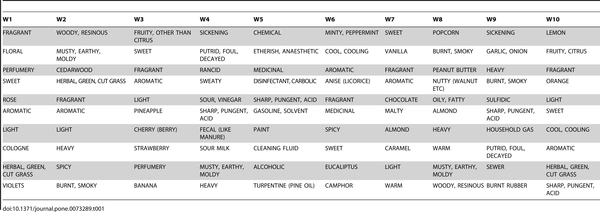10 Different Smells Are Detectable By Your Nose: How Did Popcorn Make The List?

Some days, the only smells you seem to remember are the bad ones. Other times, the light, airy scent of flowers or the crisp bite of fall keep wafting by you at just the right moment. Scientists have now determined all of these fleeting, amorphous aromas can actually be lumped into a clean group of 10 easily detectable categories.
While the researchers from Bates College and the University of Pittsburgh present 10 basic categories, they concede that natural smells are likely a mixture of many different scents. Their category breakdown includes 10 general scents the human nose can readily detect.
1. Fragrant
The research team lumped fragrant smells in with perfumery, floral, cologne, and rosy smells. Fragrant scents are the ones that seem light and natural, what is typically described by perfume and cologne manufacturers as “grassy” or “herbal.”
2. Woody/Resinous
Your nose easily picks up deep, earthy smells that remind you of the outdoors, the researchers claim. The smells are distinct to nature, which makes them easily recognizable. The team included with woody/resinous scents of musty, moldy, heavy, burnt, and smoky.
3. Non-Citrus Fruity
Opposite the hearty musk of the outdoors are the light, fresh scents associated with strawberries, banana, and certain perfumes that draw upon these natural aromas. Unlike the sharp, bitter freshness of lemon, non-citrus fruit smells may feel more “smooth” or “silky” to the nose.
4. Sharp/Pungent
You know it the moment you smell it. These smells include sour milk, fecal matter (e.g. manure), sweat, and the natural smell of things that have turned putrid or foul. These scents make you reel the instant you detect them. Oniony and garlicky smells also fall into this category.
5. Chemical
Your nose is particularly adroit at detecting synthetic smells. Even the most realistic perfume has its limits. It’s for this reason you’re able to quickly sniff out bleach and gasoline, or paint and felt tip markers. Researchers also included alcohol and disinfectants in the category.
6. Minty/Peppermint
Described as cool, fresh, exhilarating, the minty/peppermint smell has perhaps no rivals in the scent world. It’s become synonymous with cleanliness and is ubiquitous among oral hygiene products for this very reason. The researchers also include spicy in this category.
7. Sweet
Diverging from sweetness detected in fruit, the researchers classified as "sweet" the aromas of things like chocolate, vanilla, almond, and malty scents. They’re warm, and often light. Oftentimes they’ll be sold as “creamy” or “rich.”
8. Popcorn
Popcorn as the figurehead for the group may be jarring, as its neighboring groups are so unmistakable (not to say popcorn isn’t). But popcorn was grouped with other distinct smells, such as peanut butter, burnt, nutty, heavy, and warm. It’s that earthy smell that isn’t quite grass or wood.
9. Sickening
Sickening and decaying smells are a step beyond sharp/pungent smells. It’s sewage, burnt rubber, sulfuric acid, and household gas. Sickening smells are those that cause you to dry heave when the nose detects them in heavy enough concentrations. They aren’t merely “unpleasant;” they’re usually insufferable.
10. Lemon
Who could forget the trusty scent of lemon? Used in cleaning products for decades, the scent of lemon and citrus connotes freshness — like mint — with a hint of sweetness and sharpness that makes it unique from the others. It’s light and acidic, and the nose knows it instantly.
Understanding The Smells
Each of these smells, the researchers argue, reveals a component of the human condition that alerts you to your environment. Chemical smells signal danger; nutty, popcorn smells tell you there is food nearby. Each plays a role in ensuring your survival.
"You have these 10 basic categories because they reflect important attributes about the world — danger, food and so on. If you know these basic categories, then you can start to think about building smells,” Prof. Jason Castro, of Bates College, told the BBC. "We have not solved the problem of predicting a smell based on its chemical structure, but that's something we hope to do."
In conducting their study, which the team published in the journal PLoS ONE, they whittled thousands of perceived smells down to 144, and from there boiled the list down to 10. Part of the challenge in performing such a study lies in translating a subject’s perception of a smell into an objective label. Bananas don’t smell like anything, per se, except for other bananas. Labels of smooth, fruity, and sweet approach its actual scent, but they don’t encapsulate it.
“Another possibility is that early olfactory processing only resolves odor quality to a degree sufficient to rank relative pleasantness,” the team states in its report, “with further parsing of this percept into discrete categories occurring through mechanisms involving learning and context.”
In other words, developing 10 categories that each contains 10 similar smells may be the best approximation for talking around a scent that can’t be formulated into words — at least not in totality. When you’re young, your brain only discerns between pleasant or unpleasant smells. It’s through gaining experience — eating a banana, being told a perfume smells like banana — that you gain a fuller understanding of its true scent.

Source: Castro J, Ramanathan A, Chennubhotla C. Categorical Dimensions of Human Odor Descriptor Space Revealed by Non-Negative Matrix Factorization. PLoS ONE. 2013.



























